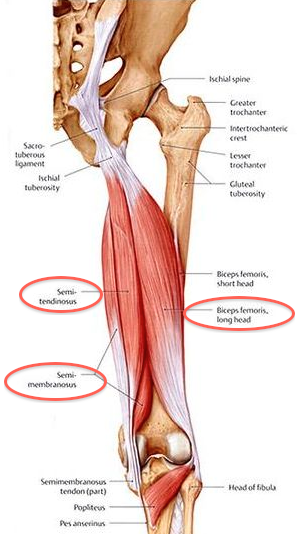Hamstring pain is a uncommon cause of pain along the back of the hip and thigh. Sitting pain is quite common with this injury, with patients attempting to shift body weight away from the affected side and onto the opposite hip to minimize the pain, especially during times of prolonged sitting, such as long car rides.
Office Appointments and Telemedicine with Dr. Carreira

You can also book an office appointment or a telemedicine visit by calling Dr. Carreira’s office at 404-355-0743. Book now.
Location of Hamstring Pain
The proximal hamstring tendons connect the three hamstring muscles to the ischial tuberosity, a bone located in the buttocks at the bottom of the pelvis. The ischial tuberosity is also known as the SITS bone, due to the fact that it is the main area onto which we sit and a frequent area of pain in patients with proximal (close to the buttock) hamstring pain.
Anatomy of the Back (Posterior) of the Thigh

Types of Hamstring Injuries
Acute rupture of the hamstring tendons is a painful condition commonly caused by rapid acceleration or deceleration. This sort of rapid change of speed is often experienced in sporting activity such as soccer, football, and water skiing. High grade injuries, consisting of full tears of the tendon or near complete tears, are typically associated with severe pain initially in the first 2 days, followed by pain, bruising and difficulty walking which gradually improve.
Chronic pain in the hamstring is typically associated with high level athletes who have put a lot of stress on the hamstring over many years, such as long distance runners. The pain is typically associated with exercise and with sitting.
Treatments for Hamstring Pain
Most hamstring injuries heal with conservative treatment consisting of NSAIDS (non-steroidal anti-inflammatory drugs), physical therapy, and rest and ice. Other non-surgical treatment options include platelet-rich plasma (PRP). If conservative measures fail and symptoms continue, surgical debridement and surgical hamstring re-attachment may be performed in rare cases.
Rarely and for high grade or complete proximal hamstring tendon ruptures or for degeneration and partial tearing, surgery is indicated to clean the damaged tendon and reattach it.
Study Outcomes of Research on Proximal Hamstring Tendinosis and Partial Ruptures
In a recent study Dr. Carreira and colleagues published in the Journal of Orthopedics, a search was performed for the relevant clinical literature for the treatment of proximal hamstring tendinosis and partial hamstring ruptures. This review found 21 studies that met the inclusion criteria. Six articles discussed surgical options and outcomes, 2 articles discussed MRI and ultrasound as diagnostic therapeutic modalities, 4 articles discussed PRP, 1 study discussed shockwave therapy, and 8 studies discussed conservative, non-invasive treatments.
The literature review revealed strong evidence that surgical treatment of proximal hamstring injuries is safe and effective. There were a total of 266 patients in all the articles that studied the surgical treatment of proximal hamstring tendon injuries:
- 52% of patients had excellent outcomes
- 44% of patients had a good outcome
- 4% patients had a fair outcome, and
- 7% of patients had a poor outcome.
A total of 82% of patients were satisfied or somewhat satisfied following surgery.
Finally, across all surgical outcome studies 99% of patients reported improvement following surgery and 99% of patients returned to strenuous activity and sports following surgery.


